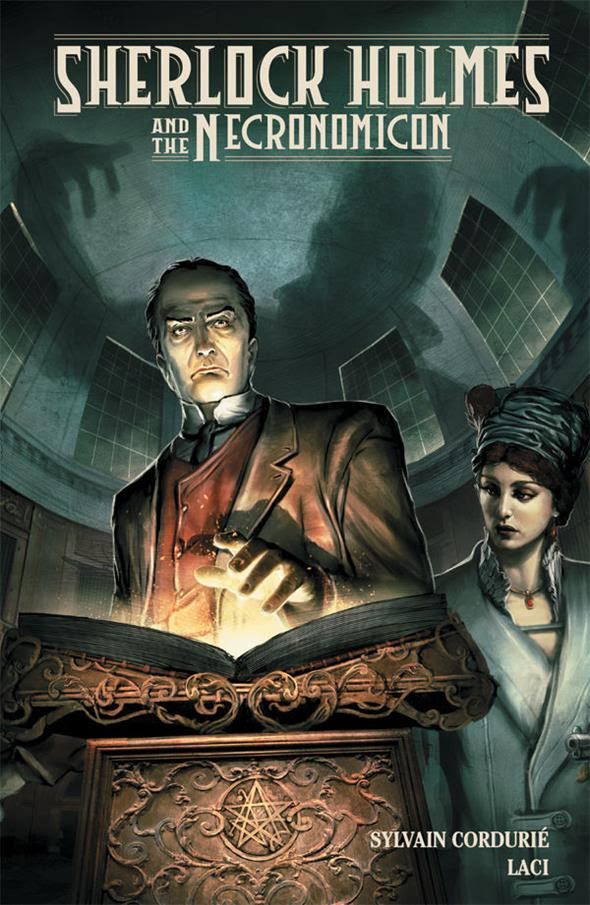
 Many judge a man by what he has read. From Apollonius’ “The Conic Sections†to Hume’s “A Treatise of Human Nature†the infamous Sherlock Holmes has been busy. After his confrontation with vampires in 19th century London and the confrontation with Moriarty at Reichenbach Falls, Holmes decides, under an assumed name to “get lost.†While on a voyage through Antarctica, Holmes writes to Watson about how life seems so clear now and how he’s kicked his drug habit and has had a chance to reflect and attack a challenging reading list. But then strange things start happening that like a siren’s call leads Holmes back to London. It is where this graphic novel takes a nefarious turn.
Many judge a man by what he has read. From Apollonius’ “The Conic Sections†to Hume’s “A Treatise of Human Nature†the infamous Sherlock Holmes has been busy. After his confrontation with vampires in 19th century London and the confrontation with Moriarty at Reichenbach Falls, Holmes decides, under an assumed name to “get lost.†While on a voyage through Antarctica, Holmes writes to Watson about how life seems so clear now and how he’s kicked his drug habit and has had a chance to reflect and attack a challenging reading list. But then strange things start happening that like a siren’s call leads Holmes back to London. It is where this graphic novel takes a nefarious turn.
Sylvain Cordurie’s “Sherlock Holmes and the Necronomicon†delves into a world riddled with mad men and the dark arts. Men who believe they are in control are not nearly as frightening as those who truly wield power. As always Queen Victoria is in the mix. Writers tend to take advantage of this queen’s long reign. In an episode of “Doctor Who†she creates Torchwood, an anachronism for an agency to keep an eye on The Doctor and any other aliens who may endanger the crown. In the same episode it is also alluded to that the queen has werewolf ancestry. Being fiction writers can do that. In Cordurie’s telling of this tale, it isn’t a comedic turn, rather the long-reigning monarch has a secret agency where both she and they are no joke.
The Necronomicon is nothing to laugh at either. Most well known for being a fictional text on magic by H.P. Lovecraft, this book has become a type of boogeyman in literature. If you want to make something scary put the Necronomicon in it. According to Lovecraft’s writings, it is supposed to be an aged workbook that is ancient Arabic in origin. Now take a so-called mysterious place, shrouded in knowledge that would drive a sane person mad and you have a nice backdrop for a mystery for Sherlock Holmes to solve.
What makes this graphic novel so effective is the use of the artwork. Each panel are rich illustrations of the action taking place. The characters seem to have real movement and the muted tones make even the brightly-lit day scenes sinister. Laci and company know how to heighten tension and make things come alive without intruding on the dialogue.
It’s difficult to tell how Holmes will come out of this. He’s dealing with things out of his control and people he can’t deduce. Even in his hometown the great detective is out of his element. At a certain point in this graphic novel Holmes returns to the Apollonius text. It isn’t the Greek poet, but the long dead Greek astronomer, the best known Geometer. Ironically several of his texts had been translated in Arabic. This clue that the reader is given is like a major piece of a puzzle, that when paid attention to leads to that moment where you feel like you’re the smartest person in the room.
Reading anything related to the character Sherlock Holmes and automatically you judge the work against every recent retelling. Does it hold up? Is the storyline worth the effort? What good writers do is pull you into a world and take away your preconceptions of where the book should go. In Cordurie’s case, she doesn’t care what you think and that’s the best kind of writer.

Leave a Reply